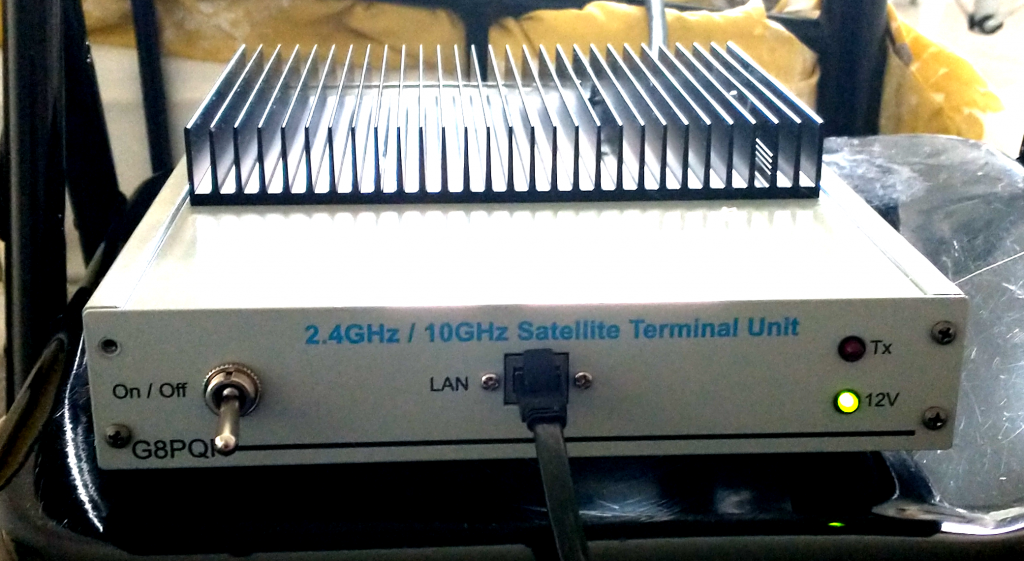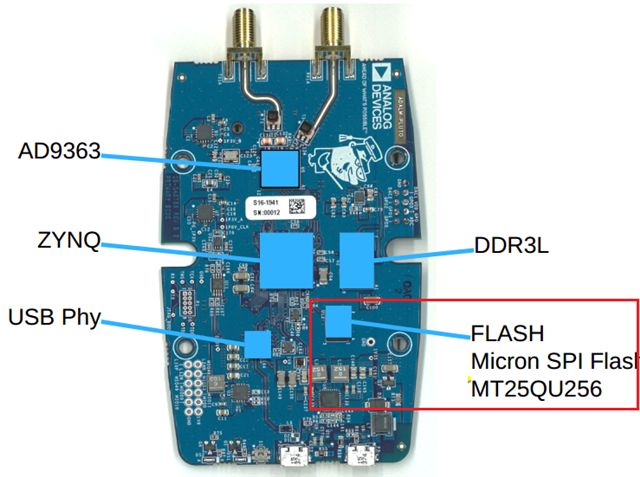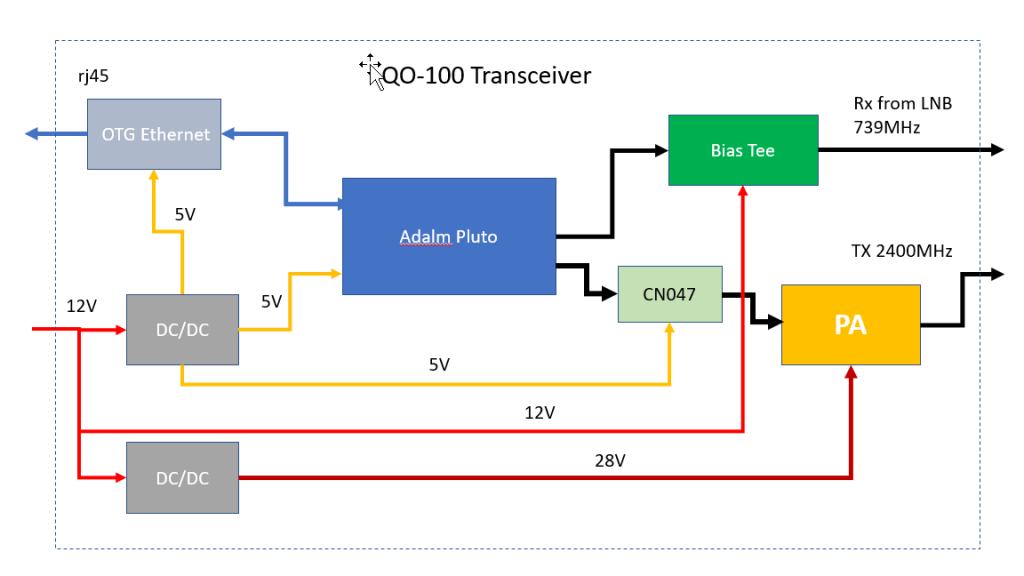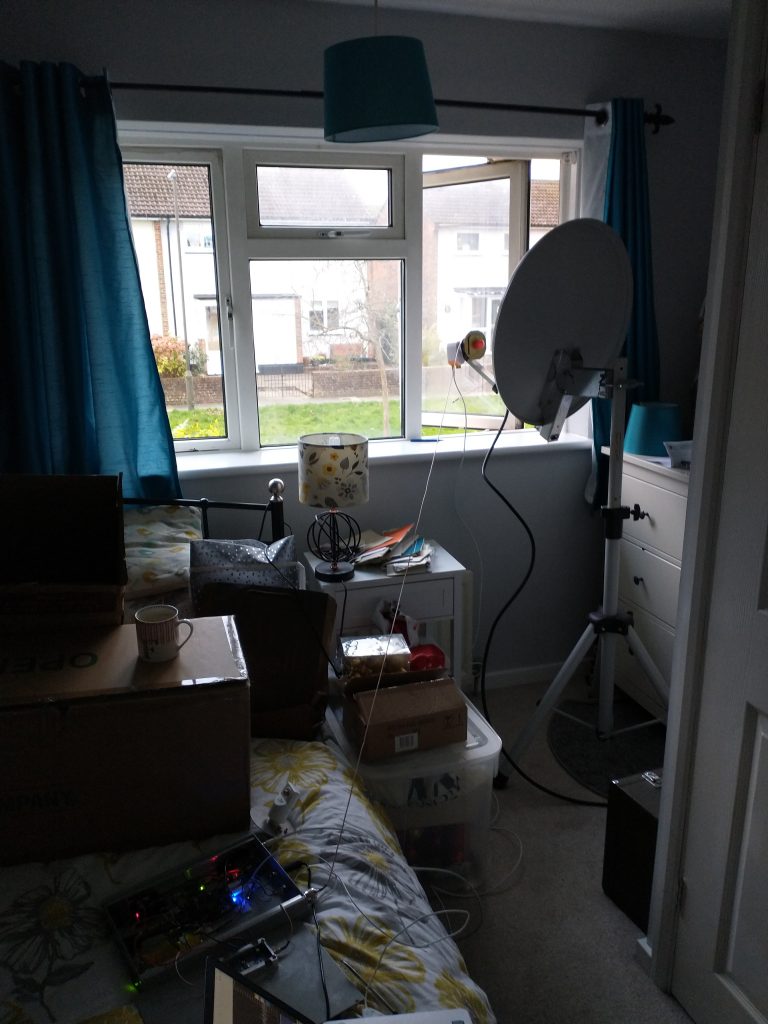My QO100 station is based around the Analog Devices Adalm Pluto SDR development system. Quite a popular solution as it can be used both for tx and rx. Its a common alternative to using a transverter and uhf ssb transceiver and a separate rx only sdr, which is another popular approach.

Adalm Pluto
The Pluto is a medium cost Software Defined Radio (SDR) system intended as an integrated learning environment for teaching purposes. The manufacturer expects the added bonus that students will end up being familiar with their range of devices and solutions. Unlike alternatives such as the Lime SDR and Lime Mini SDR the Pluto also supports an integrated computing unit running Linux. This implementation supports a command prompt using SSH and supports networking over the USB port,

The Adalm Pluto offers one receive channel and one transmit channel which can be operated in full duplex, capable of generating or measuring RF analogue signals from 325 to 3800 MHz, at up to 61.44 Mega Samples per Second (MSPS) with a 20 MHz bandwidth. The PlutoSDR is completely self-contained, fits nicely in a shirt pocket or backpack, and is entirely USB powered with the default firmware.

The first USB connector (the middle one) is the USB OTG connector (can be the USB HOST connector (cabled to a USB peripheral), or the USB peripheral connector (cabled to a USB Host)). The second USB connector (the one on the side) is for power only when running in Host mode. Separate Rx and TX ports are connected to the AD9363 transceiver and the system is controlled by the ZYNQ “System on a Chip” (SoC). Internally this devices supports an ARM cortex processor plus programmable logic and Input/Output.
As the Pluto is supported by the popular SDR software SDR Console it is very nearly ideal for our purpose. It can transmit at 2400MHz and it can receive the output of a standard 10GHz tv satellite LNB which will fall around 739MHz. The receive noise figure is good (<3.5dB) so sensitivity will be OK. It has two main drawbacks we need to overcome. Firstly the power output is tiny, just a couple of milliwatts. Secondly and more seriously the temperature stability of the main frequency reference the device has (a 40MHz TXCO) is only 25 parts per million. At 2400MHz this works out at +/- 60kHz indicating there will be too much drift for practical narrowband SSB operation. (Help!) We will overcome both of these limitations.
Transceiver Hardware
The Pluto needs a number of supporting modules which I assembled into the transceiver box shown at the top of the page. The interconnections are shown in the diagram below.

The additional components I used were:
12V to 5V DC/DC converter. Source Ebay:
12V to 28V DC/DC convertor. Source Ebay:
2400MHz output filter (Source Passion Radio)
CN0417 Pre Amplifier. Source Passion Radio
Bias Tee Unit. Source Passion Radio
SG Labs high gain 20W amplifier unit. Source SG Labs
Key Issues Encountered
Low Transmit Power. The low power output of the Pluto is first amplified by the Analog Devices CN0417 amplifier unit. This unit is designed for use with the Pluto in the 2400MHz band and includes band filtering. It can delver about 100mW. It runs quite hot. The output of this amplifier is fed into the SG Labs 20W amplifier (V3) which needs about 50mW to drive the amplifier to full power. The SG Labs unit is very nicely made and includes not only a voltage test point for forward and reflected power on the output but also an indication of input power. The output power is 20W when powered from 28V. This is more than you need for narrowband operation. https://www.sg-lab.com/AMP2400v3/amp2400_v3.html
Frequency Stability, To get over the poor frequency stability you need to replace the standard TXCO on the Pluto with a higher spec unit, (or feed a GPS locked 40MHz reference signal from a GPS disciplined oscillator GPSDO). I haven’t much experience with SMD components and my eyesight is not as good as it was, so I opted to buy a Pluto unit already fitted with a 40MHz TXCO with a 0.5ppm spec as opposed to the standard 25ppm unit. (From DJ4ZZ http://www.jdelektronik.de/ENGLISH/index.html) The existing TXCO had been removed and a daughter board fitted with the new smaller TXCO soldered onto this board. All was well until I stupidly managed to damage the Pluto board by breaking the USB connector. Don’t do this yourself. It’s quite fragile. My attempts to solder the connector back were unsuccessful. After a lot of frustration realising my Pluto was now unusable, I ended up buying a standard off the shelf Pluto unit. I had then had the job of unsoldering the standard TXCO and swapping over the high spec unit from the original DJ4ZZ Pluto board, So I still ended up doing what I was trying to avoid in the first place! Luckily for me it worked and I have a stable transmission.
Push to Talk (PTT) is an issue. V3 of the SG Labs amplifier has an RF VOX circuit to switch the PA into transmit. It’s fast acting with an adjustable hang time as well as a manual PTT line, pulled to ground for transmit. Without an amplifier with this arrangement some stations manually switch the PTT or more likely bias the PA into transmit the whole time. This is because the standard Pluto firmware and SDR console doesn’t seem to support generating a PTT output. On my Pluto I have installed the F5OEO tv transmission firmware. This still works fine on the NB transponder with SDR Console but has a range of extra facilities. There is information to suggest that you can set one of Pluto IO lines to achieve this and I have GPO and GP1 wired up to a small relay board piggy backed on the unit. I had trouble getting this to work, so the RF VOX and the amplifier is very useful. Other stations have got it working fine apparently so I will just need to come back to it in the future.
TV Transmission
The F5OEO Pluto firmware is one way of generating a DVB-S2 digital television signal that can be sent via the wideband transceiver.
I have managed to use this to send and receive TV over the wideband satellite transponder.
LNB and Antenna Hardware
The LNB I am using I obtained from DJ4ZZ. Its a Quad LNB Golden Media GM204 modified with a stable TCXO.
- TCXO 0,5ppm
- IF: 739,550 MHz
- H/V polarisation switched 12V/19V
My unit was already fitted with the DJ4ZZ POTY antenna that made setup straightforward. I noted though he still does the brass POTY antenna and LNB as separate items on his website he doesn’t seem to do the POTY antenna ready fitted to the LNB. I don’t think it is hard to do.

Hers a picture of the 60cm dish and tripod being tested out the spare bedroom window over the Christmas holidays in 2020. The slightly disassembled transceiver unit can be seen on the bed.

SDR Console software
I am using Simon Brown’s G4ELI excellent software SDR Console to drive the Pluto for both TX and Rx https://www.sdr-radio.com/
